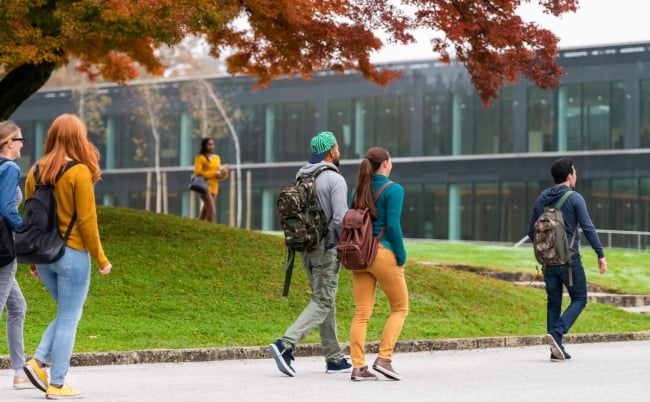You have /5 articles left.
Sign up for a free account or log in.

iStock/Getty Images
Now that the fall is complete and the spring in full swing, eyes have turned to the upcoming semester. A number of colleges and universities, spurred by promising vaccine news and the beginning of admissions season, have announced that they plan to return to “normal” this upcoming fall. In-person classes and residential experiences will be the norm, administrations have said.
Some higher education experts are beginning to look ahead to that return, including the possible equity concerns that may arise and how institutions can address them.
“We shouldn’t be talking about opening up normal, we should be talking about opening up better,” said Wil Del Pilar, vice president of higher education policy at the Education Trust, an equity-focused think tank. “We know that a lot of four-year and two-year institutions weren’t providing the best services to low-income students and students of color.”
Del Pilar said the pandemic’s negative effects on students of color will likely be difficult to erase. Data from the National Student Clearinghouse show declining fall enrollment for freshmen, with particularly steep drops nationally for Black, Hispanic and Native American students.
“I do have concerns around what is a classroom going to look like, especially for low-income students and students of color. If you had underrepresentation in the classrooms before, is it going to be worse?” he said. “More broadly, I’m concerned about campus racial climate. We know from the literature that a sense of belonging and having some critical mass of students is important to the experience and being able to process experiences.”
Del Pilar also said that learning loss may be something colleges and universities will have to deal with this upcoming term with incoming freshmen, who may need more support than they typically would.
Shaun Harper, executive director of the University of Southern California's Race and Equity Center, said he worries still about keeping students and employees safe amid a return to nearly full in-person learning. While some projections of vaccine uptake are optimistic, the country may still be facing a public health threat when the first classes start in August.
Underresourced institutions -- which are more likely to serve low-income students and students of color -- may have a harder time keeping people safe if they reopen, Harper said. Wealthy campuses can afford the testing, tracing and daily screening apps that tech schools and community colleges cannot.
Community colleges, said Lane Glenn, president of Northern Essex Community College in Massachusetts, may not be ready or able to return to in-person instruction this fall. One thing they may have to worry about more than other campuses is how many of their students are vaccinated. Data have shown that people of color have been receiving COVID-19 vaccines at lower rates than white people. Access likely plays a role in that, along with vaccine hesitancy.
“About 43 percent of our students are Hispanic. We are a majority population of students of color,” he said. “It’s likely going to take longer to reach those populations than more affluent white families whose students are attending prestigious, selective, private universities.”
Community colleges have less control over their students than do residential colleges and may not have the budget to switch from in person to remote again if things go wrong. All that means they may be slower to resume fully in-person learning.
Harper said he’s also concerned about support for students experiencing anxiety with the return to crowded spaces and about grief and trauma from students who have experienced loss this year.
“People of color have experienced disproportionately higher rates of infections and deaths from COVID-19, which means that when students and employees return to campus, there’s a higher likelihood that students and employees of color will have experienced significant loss of a loved one or friend or someone in their community compared to white students,” he said. “Colleges and universities were already struggling with meeting the mental health needs of students pre-pandemic.”
Colleges and universities could also consider maintaining some of the expanded telehealth services for mental health support that many implemented last year, said Elizabeth Banes, an analyst at Ithaka S+R who examined equity in relation to last fall’s reopening plans.
"While it may not be as critical to offer digital services because there will be the opportunity to reconvene in person, I think there still is really an opportunity to integrate some of those technological advances into the fall."
Banes also said colleges could continue the practice that some started during the pandemic of giving targeted aid to needy students in the form of emergency grants, food subsidies and technological equipment.
“The pandemic really brought light to what was an underlying pandemic of widespread housing and food insecurity across student populations in this country,” she said. “That targeted assistance to those in the greatest need is something that we should carry through with us, and we should not assume that just because we’re back on campus face-to-face that those basic needs are being met.”
Colleges and universities could also consider maintaining some of the flexibility of this past year. While complaints about online learning and Zoom fatigue from students were plentiful, some students who attend college while working, caring for children or living with a disability, have said that online learning has made things easier for them.
“We’re listening to our students and our students are saying to us they’re overwhelmed. The ones that are working are working more and balancing childcare,” said Glenn. “They have found that they prefer a hybrid approach. If they’re going to be in person, maybe they’re in person less often than they used to be.”
Students at Northern Essex Community College have indicated support for more synchronous classes to provide some structure, but traveling to campus and commuting is not generally what they demand. Other trade schools and community colleges have also suggested that the old model of coming to class five days per week will likely be a thing of the past for them. After their trial by fire last spring, many faculty members have become more confident and comfortable teaching online.
Some colleges should also think about retaining the test-optional admissions policies they enacted this year, Del Pilar said.
In California, the Governor’s Council on Postsecondary Education began considering questions of return and equity early on. Lande Ajose, chair of the council, said ideas were circulating in April.
“In conversation with a colleague, we were saying, ‘At some point, it's hard to imagine, but at some point this whole pandemic will be over and we will return to something that approximates our next iteration of normal,’” she said. “What are the kinds of decisions we need to be making along the way so that we emerge from the pandemic with a greater focus on equity and not just mere acceptance of the way in which we defined or understood equity in January of 2020?”
After interviewing 90 students and 200 people total, the council’s task force released a report called "Recovery With Equity" that outlines 11 different recommendations for higher education. Some of those focus areas, such as fostering inclusive institutions and improving the diversity of faculty, have been part of the conversation for a long time. Others, such as subsidizing internet access for eligible students, gained visibility with the pandemic.
Over all, Ajose said she’s hopeful for the future of higher education post-pandemic.
“I’m really optimistic that we have champions all across the state who are deeply committed to equity for students and deeply committed to institutional change,” she said. “I really feel hopeful for what we’ll be able to accomplish.”








